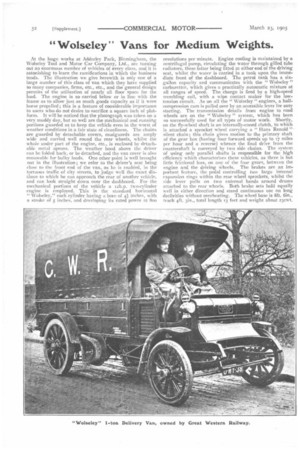" Wolseley " Vans for Medium Weights.
Page 28

If you've noticed an error in this article please click here to report it so we can fix it.
At the huge works at Adderley Park, Birmingham, the Wolseley Tool and Motor Car Company, Ltd., arc turning out an enormous number of vehicles of every class, and it is astonishing to learn the ramifications in which the business tends. The illustration we give herewith is only one of a large number of this class of van which they have supplied to many companies, firms, etc., etc., and the general design permits of the utilisation of nearly all floor space for the load. The engine is so carried below or in line with the frame as to allow just as much goods capacity as if it were horse propelled ; this is a feature of considerable importance to users who do not desire to sacrifice a square inch of platform. It will be noticed that the photograph was taken on a very muddy day, but so well are the mechanical and running portions guarded as to keep the vehicle even in the worst of weather conditions in a fair state of cleanliness. The chains are guarded by detachable covers, mudguards are amply wide and carried well round the rear wheels, whilst the whole under part of the engine, etc., is enclosed by detachable metal aprons. The weather hood above the driver can he folded back, or be detached, and the van cover is also removable for bulky loads. One other point is well brought out in the illustration ; we refer to the driver's seat being close to the front end of the van, as he is enabled, in the tortuous traffic of city streets, to judge well the exact distance to which he can approach the rear of another vehicle, and can look straight down over the dashboard. For the mechanical portions of the vehicle a 12h.p. two-cylinder engine is employed. This is the standard horizontal " WoIseley," each cylinder having a bore of 41 inches, with a stroke of 5 inches, and developing its rated power at 800 revolutions per minute. Engine cooling is maintained by a centrifugal pump, circulating the water through gilled tube radiators, these latter being fitted at either end of the driving seat, whilst the water is carried in a tank upon the immediate front of the dashboard. The petrol tank has a sixgallon capacity and communicates with the " Wolseley " carburetter, which gives a practically automatic mixture at all ranges of speed. The charge is fired by a high-speed trembling coil, with a wipe contact maker for the lowtension circuit. As on all the " Wolseley " engines, a halfcompression cam is pulled over by an accessible lever for easy starting. The transmission details from engine to road wheels are on the " WolseIey " system, which has been so successfully used for all types of motor work. Shortly, on the fly-wheel shaft is an internally-coned clutch, to which is attached a sprocket wheel carrying a " Hans Renold "• silent chain; this chain gives motion to the primary shaft of the gear box (having four forward speeds up to 17 miles per hour and a reverse) whence the final drive from the countershaft is conveyed by two side chains. The system of using only parallel shafts is responsible for the high efficiency which characterises these vehicles, as there is but little frictional loss, on any of the four gears, between the engine and the driving wheels. The brakes are an important feature, the pedal controlling two large internal expansion rings within the rear wheel sprockets, whilst the side lever pulls on two external bands around drums attached to the rear wheels. Both brake sets hold equally well in either direction and stand continuous use on long declivities without overheating. The wheel base is 8ft. 6in., track 4ft. sin., total length 13 feet and weight about 23cwt.




























